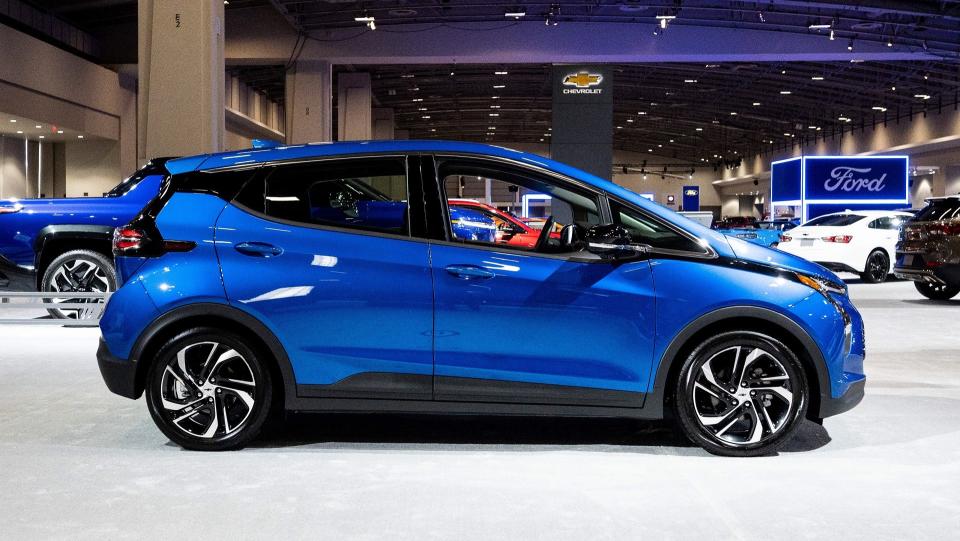Inflation Reduction Act: These 31 Electric Vehicles Qualify for EV Credits

This week, the Inflation Reduction Act passed the House of Representatives and was signed into law by President Biden.
Inflation Reduction Act: What Savings Are Instant Rebates vs. Tax Credits
Rising Gas Prices: The True Cost of Going Electric
One of the biggest pieces of U.S. legislation in history tackling climate change, there’s been a lot of chatter about ways consumers can take part in the effort and get money back, too. A good chunk of the $369 billion allocated for eco-friendly measures will go toward providing tax credits for the purchase of electric vehicles.
There’s just one problem: experts have been saying not many EVs will apply under the current guidelines. As GOBankingRates previously reported, the law stipulates that the majority of key components for EVs must be made in North America or a country in which we have free trade agreements, including 50% of the battery parts and 40% of the minerals.
Yet currently, 90% of minerals used in current production are processed in China, according to Katherine Stainken, vice president of policy for the Electrification Coalition, per Spectrum News.
But all hope is not lost. The U.S. Department of Energy released new information on August 16 outlining 31 makes and models of electric cars that meet the eligibility standard for the credits. Owners can receive up to $7,500 for the purchase of a new EV sedan model with a manufacturer suggested retail price (MSRP) under $55,000 and up to $80,000 for SUVs and trucks.
The following list of vehicles with model years of 2022 and 2023 all include final assembly in North America, verified through information submitted to the National Highway Traffic Safety Administration (NHTSA) and FuelEconomy.gov:
2022 Audi Q5
2022 BMW 3-Series Plug-In
2022 BMW X5
2022 Chevrolet Bolt EUV (manufacturer sales cap met)
2022 Chevrolet Bolt EV (manufacturer sales cap met)
2022 Chrysler Pacifica PHEV
2022 Ford Escape PHEV
2022 Ford F Series
2022 Ford Mustang MACH E
2022 Ford Transit Van
2022 GMC Hummer Pickup (manufacturer sales cap met)
2022 GMC Hummer SUV (manufacturer sales cap met)
2022 Jeep Grand Cherokee PHEV
2022 Jeep Wrangler PHEV
2022 Lincoln Aviator PHEV
2022 Lincoln Cosair Plug-In
2022 Lucid Air
2022 Nissan Leaf
2022 Rivian EDV
2022 Rivian R1S
2022 Rivian R1T
2022 Tesla Model 3 (manufacturer sales cap met)
2022 Tesla Model S (manufacturer sales cap met)
2022 Tesla Model X (manufacturer sales cap met)
2022 Tesla Model Y (manufacturer sales cap met)
2022 Volvo S60
2023 BMW Series 3 Plug-In
2023 Bolt EV (manufacturer sales cap met)
2023 Cadillac Lyriq (manufacturer sales cap met)
2023 Mercedes EQS SUV
2023 Nissan Leaf
However, it’s important to note that the U.S. Department of Energy cautions it’s best to look at the individual car’s Vehicle Identification Number (VIN) to determine the ultimate build location, as some models are produced in multiple locations (especially if they have custom details).
Credit Card Rewards and Electric Vehicles: Are They Driving Enough of a Bargain for EV Owners?
More: Credit Card Interest Rates Skyrocket While Credit Card Companies Rake in Profits — Is Tighter Regulation the Answer?
The list of applicable vehicles will continue to expand, so it’s suggested to keep checking back to the website. The U.S. Department of Energy has also noted which manufacturers have currently met the 200,000 vehicle credit cap, though this will not be relevant as of January 1, 2023 when that provision is no longer required as part of the new legislation, per CNN.
More From GOBankingRates
This article originally appeared on GOBankingRates.com: Inflation Reduction Act: These 31 Electric Vehicles Qualify for EV Credits
